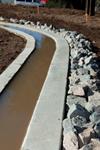
Santa Susana Site Looking Much Better
The Boeing Company's stormwater solutions have spearheaded the restoration of the Santa Susana Field Laboratory near Chatsworth, Calif.
- By Paul Costa
- Mar 11, 2013
Like installing multiple filters for the water faucet in your kitchen sink, a multitude of state-of-the-art stormwater treatment systems have been installed at the former Santa Susana Field Laboratory (SSFL) in the Simi Hills. The former rocket and energy test site near Chatsworth, 30 miles from downtown Los Angeles, faces some of the most stringent National Pollutant Discharge Elimination System (NPDES) limits for storm water runoff in the nation as regulators seek to clean waterways flowing to Mugu Lagoon in Ventura County and the Los Angeles River.
 It's no easy task. The 2,850-acre SSFL site resembles a rumpled blanket of mountainous watersheds, pocked by chemical residue and low-level radioactive contamination from America's leading rocket engine test center. But cleanup is underway to transition the site from a premier Cold War-era research and testing site -- a prime player in putting Americans in space -- to parkland atop spectacular mountain terrain amid a megalopolis.
It's no easy task. The 2,850-acre SSFL site resembles a rumpled blanket of mountainous watersheds, pocked by chemical residue and low-level radioactive contamination from America's leading rocket engine test center. But cleanup is underway to transition the site from a premier Cold War-era research and testing site -- a prime player in putting Americans in space -- to parkland atop spectacular mountain terrain amid a megalopolis.
The result of these activities shows that The Boeing Company is making solid progress. The site meets extremely stringent discharge limits established under the Clean Water Act 94 to 100 percent of the time, contingent on storm events. The runoff from the SSFL site is, in most cases, better than what you'd find in the city or a residential neighborhood. We're required to monitor storm water more often than municipalities or other industries, and when we do, we are required to meet limits that are typically at or below drinking water standards. Ironically, in most cases, runoff from SSFL gets dirtier once it comingles with urban runoff downstream.
To address the challenge, in 2008 Boeing hired an independent panel of five internationally recognized surface water experts from UCLA, University of Alabama, Humboldt State University, and other institutions to study the site, conduct public meetings, and identify remedies. Operating with broad autonomy, the panel prescribed a fusion of active treatments, best management practices and passive measures, ranked them by importance and even helped design them. Guided by the panel, Boeing implemented more than a dozen specific measures, including new sampling stations, biofiltration units incorporating native plants, pavement removal, erosion controls, culvert modifications, sediment basins, channel modifications, and rock riprap in creeks.
Of the 74,000 cubic yards of contaminated soil recently removed from the site, 20 percent of it was a direct result of recommendations by the panel. The company also built two large surface water treatment plants for $25 million. The largest one can treat 1,000 gallons per minute of runoff -- the equivalent of three swimming pools per hour -- an enormous investment for a part-time treatment system engineered to handle brief but intense downpours a few weeks per year.
During the past nine years, Boeing has spent more than $11,000 per acre to comply with NPDES limits. With so much progress, now one of the biggest compliance challenges at SSFL is not contaminants from rocket tests or energy research, but dioxins, which come from not only legacy activities but also from naturally occurring sources, such as ash from area wildfires.
To assist in addressing this challenge, Boeing will unveil a new $600,000 "biofilter" at 9 a.m. on March 20. It uses plants, soils, and filter media to capture and treat silt and water.
More work remains, especially in the 536-acre watershed at the north end of the site, and the expert panel presses on with recommended improvements each year. Yet today, SSFL serves as a model as local governments, such as the city of Los Angeles and Los Angeles County, which also face stringent discharge limits, visit the site to learn how to solve stormwater challenges in a complex ecological, technological, and political matrix.
About the Author
Paul Costa is The Boeing Company's environmental operations and compliance manager in Canoga Park, Calif.